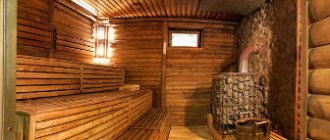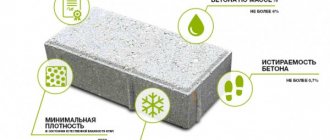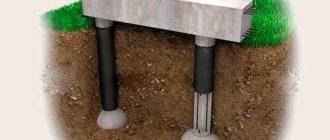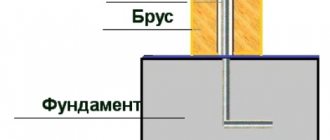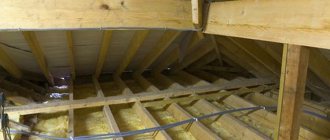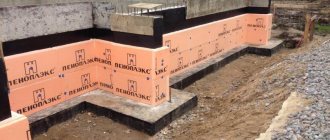To make the attic floor not only warm, but most importantly – problem-free, you need, first of all, to understand the essence of your actions, and not just blindly follow the theory or advice outlined in the video of insulating the attic from the inside with mineral wool with your own hands. Each specific design has its own nuances and features that are important and need to be taken into account. The technology of insulation with fiber materials remains one of the most popular today due to the simple installation and safety of roll insulation.
Is it possible to insulate an attic from the inside with mineral wool?
The first question that you need to decide for yourself is related to the safety of mineral fiber insulation. It’s one thing when you insulate an attic with mineral wool from the outside; this is the most expensive, troublesome and at the same time safe option for thermal insulation of a room. Another question is if the warm layer is located directly on the walls of the attic, and not on the roofing pie. In this case, there is some cause for concern:
- Most insulation materials based on mineral wool, no matter in the form of a roll sheet or in the form of mats, are impregnated with phenol-containing adhesive compositions. The release of phenol has a carcinogenic and toxic effect on the body;
- Basalt, glass or other stone fiber from which the mineral wool layer is pressed is easily destroyed and turns into dust that enters the respiratory system and settles on open areas of the skin.
Important! Advertising often presents the latest mineral wool-based insulation as an absolutely safe and environmentally friendly material that does not generate dust and does not emit phenol.
In fact, in high- and medium-price mineral wool, both parameters are reduced several times compared to old materials, but they are still present. For cheap insulation materials, the emission index and dust emission remain the same as 20 years ago.
It is possible and necessary to build thermal insulation for the attic floor, but only under one condition: the technology for insulating mineral wool from the inside of the attic must provide for complete isolation of the material from penetration into the residential or service areas of the building. You can and should use fiber insulation.
Conclusion
In order for a pitched roof to fulfill its purpose and reliably protect the house not only from external influences, but also from increased operating costs due to heat loss, it must be well insulated. In this case, living in the attic will be as comfortable as possible without overpayments, and the need for major repairs will not arise soon.
About single-layer insulation - in the previous material. Owners of wooden houses will find the article about insulating a timber house with stone wool useful. The video shows how to choose and lay stone wool correctly.
Subscribe to our Telegram channelExclusive posts every week
Pros and cons of attic insulation with mineral wool
Few people know that a third of household refrigerators have insulation based on a layer of mineral wool, only 15 mm thick. And this fact does not interfere with the safe use of the device for a long period without harm to health.
There are several very important advantages to using mineral wool to insulate an attic:
- Fiber material made from fused rock does not burn; if the wiring in the attic closes, the fireproof insulation layer temporarily blocks the source of fire;
- Mineral wool is one of the few insulating materials that can transmit warm water vapor;
- Durability, with proper installation, insulation can last on the walls from the inside of the attic for at least 40 years;
- The light weight of the insulation allows you to reduce the load on the walls and ceiling of the attic.
For your information! The most important advantage of the material is its very low thermal conductivity, approximately 0.041-0.042 W/m*oC, for comparison, for foam plastic it is 0.037-0.039 W/m*oC.
Another advantage is excellent sound insulation; of all heat insulators, mineral wool-based insulation best absorbs noise from rain, especially if the roof above the attic is covered with metal.
Negative aspects of using mineral wool for the attic
Among the most important disadvantages, in addition to the release of phenol and the formation of dust, one can note a strong tendency to watering. In direct contact with liquid water, mineral wool does not absorb it; the moisture rolls off the insulation surface in drops. But when in contact with cold, steam-saturated air, the insulation absorbs water like a sponge.
If, when installing insulation from the inside of the attic, a layer of mineral wool is exposed to rain or damp autumn fog, then most likely the insulation will have to be replaced. It is not possible to dry the material even after a month's exposure to the sun; it will still remain damp from the inside, and there will be little use from it.
Therefore, when planning your own insulation with mineral wool from the inside of the attic, first of all you will need to take care of insulating the material from moisture in any form.
How to choose mineral wool for insulating an attic roof
Almost any type of mineral fiber is suitable for laying thermal insulation from the inside of the attic, the main thing is that the material is certified and meets all the requirements for stone wool. If you have the opportunity to choose, it is best to use mineral wool of the middle and upper price segment, such as Rockmin Rockwool, Izover Ursa, TechnoNIKOL Rocklight.
The advantages of such brands of insulation include:
- Minimal release of pili and phenol;
- The presence of surface impregnation, which gives the sheets good flexibility and elasticity.
Such a mat made of mineral wool can be laid in a cell of the sheathing and not worry that the material will settle from inside the wall, and thus a window or a cold bridge will be formed in the attic wall. Mineral wool generates less dust, but still, when laying it from the inside of the attic, you must use protective clothing, gloves and a respirator.
A little about choosing tools
If you ask an experienced roofer what tools are needed to insulate the attic roof of a private house, he will shrug his shoulders and say: a hammer, a knife, a head and hands. For the most part, this is true, but there are trade secrets that not everyone wants to share.
The most important trick is in choosing a knife. If you take a simple construction and installation knife, you will suffer throughout the entire process, unevenly cutting the insulation. The blade of such a tool is too short; it does not cut through the thick layer of insulating material. In addition, the mounting knife will quickly become dull on mineral wool or foam plastic.
You can get by with a handy cutting tool (a hacksaw) or use a wide kitchen knife for cutting bread with serrated sharpening.
Professional cutting tool – a wide, long knife made of carbon steel. The blade length is 35 centimeters, the handle is made of durable plastic and is very comfortable to use.
In addition to a good knife, you really need a hammer, as well as self-tapping screws and a screwdriver, a strong cord, protective clothing, a respirator and goggles.
Tips for cutting insulation:
- the room in which you will cut mineral wool should be well ventilated;
- hands, head and, especially, eyes and respiratory tract must be protected from penetration of flying fibers;
- after working with insulation, you need to take a shower, wash your hands and face thoroughly;
- the material needs to be cut across the fiber - this will reduce flying debris;
- In order not to be mistaken in the size of the pieces, you should carefully measure their locations.
It is better not to unwind roll insulation, but to cut it directly into the roll
Thickness of mineral wool for attic insulation
The parameters of the heat-insulating layer are selected based on information about the climate and maximum temperatures in winter and summer. For example, for a temperate climate, the thickness of the mineral wool laid from the inside of the attic is assumed to be 150 mm; for more southern latitudes, 100 mm will be sufficient. If the frost reaches 25-35°C, then the insulation needs to be increased to 250 mm.
For areas with strong, constantly blowing winds, the thickness of the insulation from inside the attic space is increased by a factor of 1.5. In addition, the thickness of the mineral wool layer is greatly influenced by the layout and size of the attic. For cases where the attic is designed as a room with straight vertical walls, inscribed from the inside into the volume of the attic, 150 mm of insulation will be sufficient; in other cases, the mineral wool layer is increased to 200 mm.
Calculation using the program
When choosing a calculator program to calculate the thickness of the thermal insulation layer, the region of residence is taken into account. Otherwise, the result will not reliably reflect the real picture. For a one-time determination of the insulation thickness, it is recommended to use an online service.
Calculation using the program
Roofing pie composition
The structure of the roof slopes, which are also the walls of the attic, is not much different from a standard insulated roof. Almost always, when planning the arrangement of an attic, craftsmen leave the roof slope bare from the inside. Only the sheathing and rafters can be seen. This approach is not mandatory, but it significantly simplifies the work and makes it possible, if necessary, to change the layout of the attic from the inside.
Option with a residential attic
The simplest way to transform the under-roof space into an attic is to convert the attic into a living space. In order for a room located inside the roof to be considered an attic, the walls of the superstructure must be a continuation of the brickwork of the first floor. But more often than not, such standards are neglected and a room with sloping walls is built. In this case, the attic is insulated from the inside, like a regular roof.
Most people prefer to simply convert the attic into an attic from the inside, install false walls, insulate it with mineral wool and line it with plasterboard.
The insulation device of this option is shown in the diagram below.
Structurally, the insulation of the walls and roof from inside the attic room is constructed as follows:
- A vapor barrier membrane is laid on the roof counter-lattice;
- Two layers of mineral wool insulation are laid with a slight indentation from the film;
- On top of the rafters there are horizontal wooden slats, on which the last layer 50 mm thick is laid;
- The final stage is another layer of film vapor barrier.
To prevent the film from being torn off by air pressure, slats are sewn on the inside of the attic walls; they can be used to assemble a metal profile for laying drywall.
Insulation of the attic in the classic version differs only in that both layers of vapor barrier, both the one laid under the roofing and the film from the inside of the attic, are laid and continued to the level of the ceiling.
What to pay attention to
When converting an attic into something like an attic floor, a situation arises when part of the under-roof space ends up outside the attic space. A cavity is formed between the roof slope and the vertical wall from the inside, the dimensions of which can reach 1-2 m in width. This section of the ceiling also needs to be insulated and covered with a vapor barrier film. The same applies to the space from inside the roof, located above the attic ceiling.
Sometimes developers, when installing a small attic room in a large attic, forget about protecting the roofing. One of these options for insulating an attic from the inside with mineral wool is shown in the video
In order to prevent the insulation of the walls of the future room from becoming damp, it is necessary to cover not only the mineral wool layer with a vapor barrier, but also the sheathing of the roof slope. It is even better to lay an additional layer of polystyrene foam insulation from the inside of the roof. Warm water vapor breaking through the ceiling and walls of the attic will be easily removed by attic ventilation. If this is not done, the layer of mineral wool on the walls of the room may become damp and even freeze.
Preparing the attic roof for insulation with mineral wool
Most of the preparatory work consists of performing two procedures:
- Laying a vapor barrier membrane on the walls with fixation by horizontal slats;
- The second step is to install a wooden frame made of timber onto the walls of the attic.
It is clear that in the case where the roof slope will serve as the wall of the attic space, a roof counter-lattice can be used to lay the mineral wool. In any case, there should be a vapor barrier between the roofing and the insulation.
How to properly insulate an attic with mineral wool with your own hands
Few people like an attic room with sloping walls. Despite the certain stylishness and effectiveness of this layout, in practice such placement turns out to be not very convenient. Therefore, they always try to make an attic with vertical walls, even with a slight reduction in space.
Insulation of the inclined part of the wall, which coincides with the roof slope, is carried out according to the classic roofing pie scheme, while problems occur with vertical sections.
Insulation of attic walls from the inside with mineral wool
After the vapor barrier has been stretched, and a frame of vertical slats has already been assembled on the wall, they proceed to laying the mineral wool. First of all, individual sections or sheets are cut from a roll of insulation.
Important! The size of a separate sheet should be 1 cm less than the distance between the vertical slats.
Many mineral wool manufacturers produce insulation in the form of ready-made mats 61 cm wide. To install it on the walls, just unpack the block and place the finished pieces of mineral wool in the window frames. It is clear that in this case the distance between the wooden posts should be no more than 60 cm.
The next layer of insulation is laid with the seams staggered. If the thickness of the timber from which the frame is assembled is 100 mm, then two layers of 50 mm thick can be laid simultaneously.
The next step is to fill the frame filled with insulation with additional horizontal slats in increments of 60 cm.
The last, third layer of mineral wool is laid overlapping the remaining seams between the vertical slats and the laid mats. The last step is to stretch the second layer of vapor barrier from inside the room.
Important! The edges of the film should be laid with an overlap of 20 cm on double-sided tape.
Insulating the attic ceiling with mineral wool
Laying insulation on a ceiling frame is no different from performing work on vertical walls. The only nuance is the fixation of the mineral wool roll sheet on the ceiling sheathing.
If on a vertical frame the mats were held in place by pushing forces, then for the ceiling this is clearly not enough. Therefore, most often the installation is carried out either on an additional sheathing or using lacing made of polypropylene rope. In this case, insulation of unlimited thickness can be laid.
Insulating the attic floor from the inside with mineral wool
To form a frame for laying thermal insulation, first of all, it is necessary to lay the subfloor. This can be a screed or a sublayer filled with OSB boards. The material does not matter, the main thing is that the base is perfectly flat.
Next, a galvanized steel mounting profile is sewn onto the slabs. Logs can also be made from timber, but it will take much more time to lay the future attic floor from the inside. A vapor barrier film is laid on the supporting profiles and the free space is filled with mineral wool strips. Next, another layer of film is laid, and a floor covering made of plywood or GSP is installed.
Insulation of the attic gable with mineral wool
Installation of insulation on gable walls differs only in the installation of an additional air gap between the material with which the gable is sewn and the waterproofing film. This is followed by lathing, vapor barrier and a layer of mineral wool. The thickness of the insulation for the gable is usually chosen to be the same as that of the roofing pie.
Technology
For each private house, the thickness of the attic insulation is calculated separately using special online calculators. To carry out calculations, you need to enter the region in which construction is taking place, indicate the thickness of the walls of a private house, the thickness of the walls and ceilings in the house, the material of the walls and insulation. Such indicators allow you to avoid heat loss and choose the right thickness of thermal insulation.
In order to insulate an attic roof, special tools are needed:
- Bulgarian;
- hammer;
- manual or electric plane;
- electric drill;
- hydraulic gun;
- screwdriver;
- screwdriver;
- building level;
- hacksaw;
- goniometer.
There are several options for insulating an attic roof in a private house; the choice depends on the use of the attic.
First you need to decide on the purpose of the room, which is located under the roof. When using a room as an attic, there is no need to spend money on full insulation. In such cases, the floor of the attic (the space between the joists) is insulated, and insulation is placed in it. There is no need to install thermal insulation between the roof rafters. Mineral wool is suitable as insulation. It is laid on the floor joists and covered with a vapor barrier membrane. If you want to establish a full-fledged living space under the roof, you first need to provide a high-quality layer of waterproofing. The waterproofing layer will protect the insulation from getting wet and external influences. The waterproofing membrane is laid on top of the sheathing on the outside of the roof, secured with control sheathing bars. A slight sagging of the membrane is allowed, but not more than 100 mm.
Insulation boards are laid between the rafters so that there are no gaps left. If the insulation is carried out in two layers, laying one layer of heat-insulating material on the second is done so that the second layer overlaps the seams of the first layer (staggered laying). The next step is to lay a vapor barrier film on the insulation, protecting the material from excess moisture and condensation. The vapor barrier membrane is attached to the sheathing bars; for this you will need a construction stapler. At the joints, the film is laid overlapping and secured with tape.
First you need to decide on the subsequent use of the room under the roof.
If the flat roof will serve as a platform for a sports ground, garden, or terrace, it is important to check its strength to see if the rafter system can withstand significant loads
Next, waterproofing is laid. The algorithm for its installation is described above. A layer of expanded polystyrene with a density of 35 kg/m2 is spread on top. The polymer is covered with fiberglass, providing excellent filtration. Next, gravel is poured, and only after that you can proceed to decorating the flat roof with tiles.
Tips and tricks
The most common mistake made when insulating an attic is improper storage of mineral fiber. Mineral wool cannot be stored without packaging or in the open air. As soon as the material is purchased, it is transported to the location of the future attic and tightly covered with plastic film.
Packs with insulation are unpacked immediately before installation, and upon completion of work they must be covered with a vapor barrier. Joints and seams must be sealed with tape, otherwise dust from the mineral fiber will very quickly spread throughout the attic room.
About the need for waterproofing work
All fiber insulators, one way or another, absorb moisture. It can form due to flaws in the roof covering or the formation of condensation indoors due to temperature differences. Moisture that gets into the insulation adversely affects its condition. To prevent this from happening is the task of the waterproofing layer.
Modern construction technologies involve the use of membrane materials. They prevent the formation of condensation and at the same time do not allow external moisture to pass through.
Expert's point of view
Dmitry Kholodok
Technical director of repair and construction
Ask a Question
“Decorative wall decoration is usually vapor-permeable and allows moisture to pass through to the roofing elements and thermal insulation. I recommend protecting the insulation layer from the inside with a foil or polyethylene waterproofing layer.”
How to properly insulate a roof with a waterproofing layer in the photo:
Layer-by-layer attic insulation scheme
